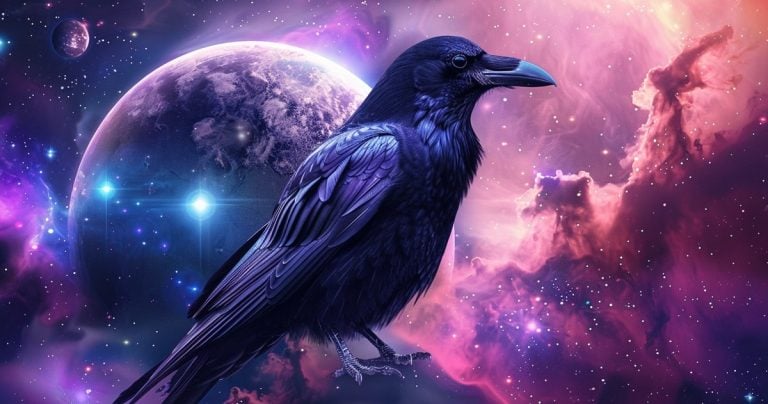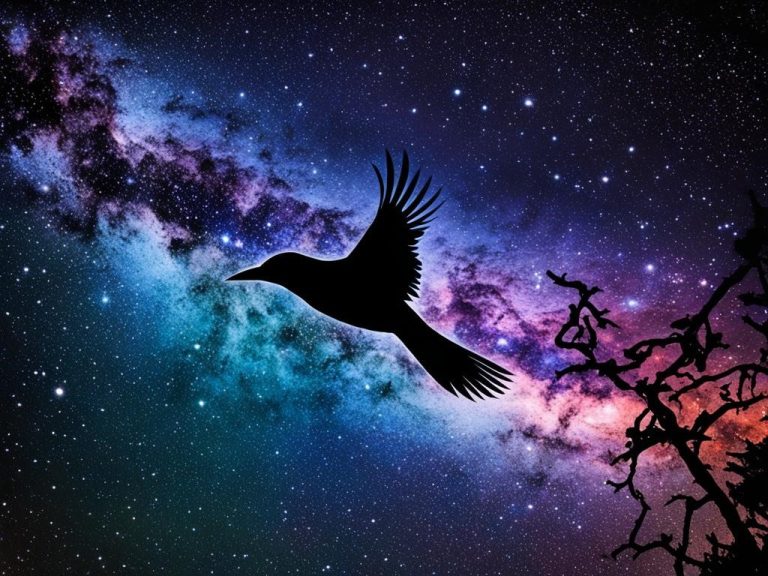Explore Stars in the Corvus Constellation
Modified: August 26, 2024 Author: International Star Registry
Did you know the Corvus constellation is in the southern night sky? It has four main stars. This grouping looks like a raven sitting on the back of a water snake called Hydra. It’s not very big, only covering 184 square degrees. But it’s very popular, coming in at the 70th spot of the 88 constellations. The brightest star in Corvus is Gamma Corvi, or Gienah. It shines with a 2.59 apparent magnitude.
Corvus is special because it has three stars brighter than magnitude 3. There’s also a big, old blue star called Gamma Corvi. It’s known for the planets and other cool things found near its stars. For example, two spinning, glowing galaxies called NGC 4038 and NGC 4039 live here, known as the Antennae Galaxies. A galaxy called NGC 4027 is here too. It has a crooked look because it probably bumped into something long ago.
If the mysteries of space intrigue you, Corvus is a great place to look. It’s a mix of stories from the past and meanings from different cultures. This constellation has a lot of history that’s just waiting for you to explore.
Key Takeaways:
- The Corvus constellation is home to four main stars and covers an area of 184 square degrees.
- Gamma Corvi (Gienah) is the brightest star in Corvus with an apparent magnitude of 2.59.
- Corvus contains three stars brighter than magnitude 3.
- NGC 4038 and NGC 4039, the Antennae Galaxies, are a pair of interacting galaxies located in Corvus.
- NGC 4027 showcases an asymmetric spiral arm likely due to a past collision.
History and Mythology of Corvus
The Corvus Constellation has a long history and stories. It was called the Raven in Babylon around 1100 BCE. It was linked with a god of rain and storms.
In Greek stories, Apollo sent a raven for water but it got sidetracked. As a lesson, Apollo placed the raven, a cup, and a snake into the stars.
Stories about Corvus often mention Apollo, a raven, and a snake. These stories highlight betrayal, change, punishment, and the bird’s special meaning in old times. Constellations of Words offers a deep look into what Corvus could mean.
Ravens connect to important gods like Odin in the Norse myths. They symbolize news, memory, and messages from the divine. Ravens are seen helping people in hunting, guarding sacred spots, and in battles across many tales. This shows how vital they were in old societies.
Corvus ties to many other myths like Ophiuchus and the stories of the Holy Grail. This shows it played a key part in various ancient tales. It proves how stories from the past used the stars to weave together grand narratives.
The word “raven” shares its roots in many languages, showing a common link. This suggests a shared past and meaning related to their sounds or the birds themselves. The importance of Corvus is seen in old texts and new interpretations, like Ovid’s works and Joseph Addison’s translations.

To learn more about Corvus, check out these sites: Kids Kiddle and Our Universe for Kids.
Astronomical Significance of Corvus
The Corvus Constellation is a vast area in the night sky. It’s in the southern hemisphere’s third quadrant. Covering 184 square degrees, it’s ranked 70th in size.
Corvus is part of the Hercules constellation family. It includes Aquila, Centaurus, and Lyra. It’s surrounded by Crater, Hydra, and Virgo, weaving it into the star formations network.
One special sight in Corvus is the Antennae Galaxies. These colliding galaxies are 45 million light years away. They show the universe’s power and draw the eye of astronomers and fans alike[^1^].
- NGC 4027 is a barred spiral galaxy 83 million light years away. It’s quite a sight at a visual magnitude of 11.7[^2^].
- NGC 4361 is a planetary nebula inside Corvus. It’s about 50’’ wide and has four lobes. It stands out in Corvus[^2^].
Corvus’s stars are key in its importance. The brightest, Gamma Corvi or Gienah, has a magnitute of 2.59[^3^]. Beta Corvi, Kit, follows as a yellow-white giant. Also, Algorab or Delta Corvi lights up the sky at 3.1 magnitute[^5^].
Scientists have found many amazing things in Corvus. For example, the VV Corvi star system or the special sights of the Antennae Galaxies and NGC 4361’s nebula are worth exploring[^6^].
The Corvus Constellation is full of amazing objects. It always captivates both astronomers and anyone who looks up at the sky.
International Star Registry and Naming a Star
Looking for a unique gift? Think about naming a star after a loved one. International Star Registry offers a way to put their name in the stars. This act lets you share a connection with the night sky that shows you care.
For those enamored by the allure of the stars, naming a star in the Corvus constellation can be a meaningful and timeless gift. Whether it’s for a birthday, Christmas, or anniversary, naming a star is a unique way to commemorate a special occasion and create a lasting tribute to a loved one.
International Star Registry offers the opportunity to name a star in the Corvus constellation, allowing individuals to leave their mark on the cosmos. By purchasing a star through International Star Registry, you not only acquire a personalized certificate and star map but also contribute to scientific research and exploration.
By getting someone their star, you’re giving more than just a present. You’re creating a bond with something that feels both amazing and endless. It’s great for marking big moments in life like birthdays or graduations.
Why Choose International Star Registry?
- Established Company: Since 1979, International Star Registry has a long history. It stands as a leader in naming stars.
- Unique Gift: Naming a star is a distinctive and lasting way to show someone you care.
- Global Reach: You can name a star from almost anywhere on earth, making it a worldwide gift.
If you want a truly unique gift, consider a star from International Star Registry. It shows you care and connects the recipient to the universe in a special way.
Star Systems and Exoplanets in Corvus
Exploring the universe, we find the Corvus Constellation. It’s full of interesting star systems and exoplanets. These make us learn more about our galaxy’s wide range and hidden secrets.
Eta Corvi is an intriguing star in Corvus, far about 59.7 light-years from us. A special feature is it has two debris disks. These disks made of dust and rocks show us how planets might start forming in this system.
In this area of space, we spot three star systems with exoplanets. These planets are close to their stars. They show us the different ways planets can be in our universe, which is not fully clear yet.
Researchers think there might be another planetary group in Corvus. But, no solid proof is available yet. This chance makes scientists eager to look for more exoplanets.
Looking at star systems here helps us understand better about planets and their surroundings. It also makes us think about where else in space life might be possible.
Cultural Significance of Corvus
The Corvus Constellation is a big deal in many places and cultures. Polynesian culture is one that celebrates this group of stars. They see it as really important.
In Polynesia, Corvus helped sailors find their way across the Pacific. They used stars like Corvus to sail safely through rough waters. Knowledge of the stars was key for them to explore and travel far.
The Marquesas Islands called the Corvus Constellation “Mee.” In the Society Islands, it was named “Metua-ai-papa.” These names show how deeply these stars were part of Polynesian life.
It’s amazing how cultures name and see constellations differently. But they all show how we connect with the sky and tell stories about the stars.
Polynesian Navigation and the Stars
Polynesian navigation was no small feat. It relied on understanding the stars and nature well. This knowledge let them sail across the open sea, reaching new islands and cultures.
The stars, including Corvus, were guides for Polynesian sailors. They helped them know where they were and which way to go. This way, the sailors discovered new places and connected different cultures.
Other Cultural Interpretations
The Corvus Constellation isn’t just important in Polynesia. In Greek myths, it plays a part in the story of Apollo and the talking raven. This adds to the constellation’s rich meaning.
The many stories and views of the Corvus Constellation keep us fascinated. They show the mix of the cosmic and human worlds.
Notable Stars in Corvus
Corvus is a starry part of the sky, known for its beautiful stars. It has Gienah, the brightest at 2.59 magnitude. This star shines the most in the Corvus Constellation.
Other famous stars in Corvus include Kraz, Algorab, Minkar, and Alchiba. They all have their own special features, lovely shining colors, and unique sizes. Hence, they make the Corvus Constellation sparkle with vividness.
It’s essential to note the unique details of each star in Corvus. Gienah, Kraz, Algorab, Minkar, and Alchiba’s features are truly remarkable. This makes studying Corvus so interesting and rewarding.
Exploring Corvus and its stars is thrilling for both astronomers and sky gazers. It helps one understand the vast and complex universe. Whether you’re new to stargazing or an expert, Corvus offers a stunning look at our cosmic neighbors.
Celestial Discoveries in Corvus
Corvus lies in the southern skies and has amazed astronomers. They explore this constellation to learn about the universe. They find celestial objects that teach us about space.
The Antennae Galaxies is a big discovery in Corvus. These two galaxies crash into each other, showing us how galaxies form and change. These galaxies teach us about the universe’s complex nature.

is also in Corvus. It is a big planetary nebula, offering astronomers a chance to study star evolution and complex cosmic structures. Scientists can learn about star life cycles and see the beauty of space by looking at NGC 4361.
Corvus in Different Cultures
Corvus is a unique constellation. It looks like a crow or raven. Many cultures see it differently and give it special names.
Chinese Astronomy
In Chinese astronomy, Corvus stars are in the South’s Vermilion Bird. This bird is in their four creatures, linked to the south and summer. Having Corvus in this bird shows its big meaning in Chinese culture.
Indian Astronomy
Indian astronomy sees Corvus as the Hasta, meaning “hand” or “fist”. This is a Nakshatra, or lunar mansion, in their astrology. It’s known for skills, craftsmanship, and bringing dreams true.
Each culture gives its own story to the Corvus stars. This shows how people all over the world treasure the stars above us, each with their unique view.
Now, let’s look at what makes the Corvus constellation special. We’ll explore more about its stars and stories.
Characteristics of the Corvus Constellation
Corvus, also known as the Crow or Raven, is a small constellation. It’s in the Southern Celestial Hemisphere. Its shape looks like a bird flying, making it cool to look at. Here’s some info about Corvus:
Size and Location
Corvus is the 70th largest constellation, covering 184 square degrees. It borders Virgo to the north and east. Hydra is to its south, and Crater is to the west. It’s visible in the south for anyone south of 65°N.
Position and Coordinates
Corvus’s right ascension is from 11h 56m 22s to 12h 56m 40s. Its declination is from -11.68° to -25.20°. These numbers help find Corvus in the night sky.
Look at the image of Corvus above. Its shape is special and easy to see. Its five big stars make a bird-like pattern. It’s amazing to spot in the night sky.
Learning about Corvus helps us love the stars more. If you like looking at the stars, checking out Corvus is a great idea. It’s a fun and learning experience for everyone.
Deep-Sky Objects in Corvus
Corvus is an amazing bunch of stars in the night sky. It shows off stunning deep-sky objects. The Antennae Galaxies, made of NGC 4038 and NGC 4039, are especially beautiful and complex.
Galaxy mergers are key for astronomers. They look at the Antennae Galaxies to learn about these mergers. This helps us understand how stars form in the universe.

NGC 4038 and NGC 4039 look absolutely stunning. Their colors and shapes are a masterpiece of the universe’s power. These galaxies are a great show of cosmic forces.
When galaxies like NGC 4038 and NGC 4039 crash together, new stars are born. This changes how galaxies look. The process is fascinating and makes us study more about space.
Conclusion
The Corvus Constellation is more than just stars in the sky. It’s rich in history and myths. These draw in both experts and fans.
Corvus has amazing celestial objects to see, like star systems. It also has exoplanets that make us wonder. You can name a star here through International Star Registry. This is a special way to mark an event or remember someone. And it helps us learn more about the stars.
The Corvus Constellation invites you to explore. Whether you’re into its stories or its science, there’s much to find. Look up, find Corvus, and see its magic. The universe is full of surprises, waiting for you to uncover them.
FAQ
What is the Corvus Constellation?
The Corvus Constellation is small and located in the Southern Sky. It’s among the 48 constellations noted by Ptolemy. This constellation shows a raven on the water snake, Hydra’s back.
What is the significance of the Corvus Constellation?
It’s among the 88 recognized constellations. People can see it from the North from January until May. It shows fully in areas between 60 degrees and -90 degrees.
How can I name a star in the Corvus Constellation?
To name a star in the Corvus Constellation, you can buy a star from International Star Registry. They provide a certificate with your chosen star name and its location.
Are there any exoplanets in the Corvus Constellation?
Yes, some star systems in Corvus have exoplanets. For instance, Eta Corvi has two known debris disks.
What is the cultural significance of the Corvus Constellation?
Corvus is culturally important in different regions. Polynesian cultures used it for sea navigation.
Which are the notable stars in the Corvus Constellation?
Notable stars in Corvus include Gienah, Kraz, Algorab, Minkar, and Alchiba.
What celestial discoveries have been made in the Corvus Constellation?
Corvus has hosted discoveries like the Antennae Galaxies and NGC 4361. These findings help us understand galaxy creation and cosmic structures.
How is the Corvus Constellation interpreted in different cultures?
In Chinese astronomy, Corvus forms part of the southern Vermilion Bird. Indian astronomy sees Corvus as the Hasta, which means a hand or fist.
What are the characteristics of the Corvus Constellation?
It spans 184 square degrees, making it the 70th largest known. It’s near the Virgo, Hydra, and Crater constellations. The declination ranges from -11.68° to -25.20°.
What deep-sky objects can be found in the Corvus Constellation?
Corvus has the Antennae Galaxies, NGC 4038 and NGC 4039. They are galaxies colliding, showing us about star evolution and mergers.
Source Links
- Constellation Corvus – The Constellations on Sea and Sky – http://www.seasky.org/constellations/constellation-corvus.html
- Corvus | Night Sky, Stars, Milky Way – https://www.britannica.com/place/Corvus-constellation
- Corvus (constellation) – https://en.wikipedia.org/wiki/Corvus_(constellation)
